699 Search Results for communication book
August 3, 2012
by Robin Parker -
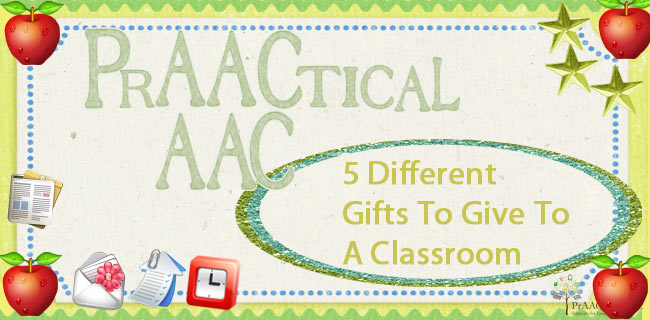
We can’t believe there are only a few weeks left before school starts. We have been talking to teachers, scheduling school and teacher trainings, helping to prepare communication dictionaries, and making recommendations for classroom materials. We realized that there are some bigger resources that would help MANY students in a classroom and even a school. These are gifts that might cost a lot of money ($150 or more) or a lot of time to set up (but are free). We realized that these would be great gifts for a parent group (PTA’s/PTO’s) or charitable organizations/foundations to give to a teacher, classroom, or school that has students who use AAC even though the gift will benefit ALL learners. Give a gift before school starts or after a successful fundraiser. 5 Great Gifts to Give to A Classroom News-2-You – A symbol based current event newspaper that allows ALL students to talk... [Read More...]
August 1, 2012
by Carole Zangari -
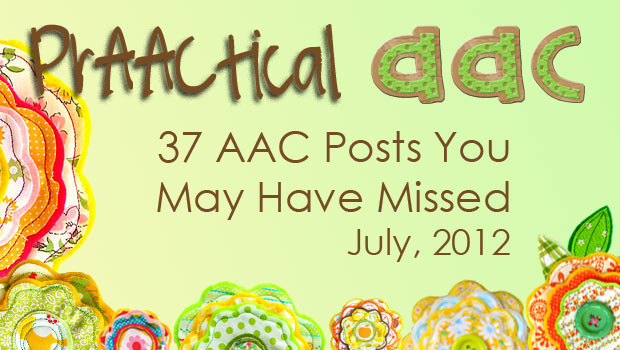
Biennial Conference: ISAAC 2012 PrAACtically There: ISAAC 2012 Day 1 at ISAAC 2012: What You Should Know About AAC’s Expanding Role in Health Care ISAAC 2012, Day 2: AAC Goes to Preschool ISAAC 2012, Day 3: Let the Games Begin ISAAC 2012, Day 4 – The Fives 5+5 Commandments for Speech Output Communication 5 Under-Used Strategies in AAC 5 Online Notebooks Full of AAC 5 Adapted Play Resources for Children with Motor Impairment – PrAACtical Thinking 92 Free or Lite Versions of AAC Apps PrAACtical Alert: Free AAC Evaluation App This Week Visualize 9 Nice Things to Say to Students who AAC PrAACtical Thoughts About Challenging Behavior PrAACtical Resource: Searching for AAC Devices with SpeechBubble AAC Assessment Round-Up 5 Ways to Use Rating Scales to Enhance Communication with AAC PrAACtical Alert: The World’s AAC Conference Comes to You (Well, a little bit of it) Power of the Visual Planner: 20... [Read More...]
July 29, 2012
by Carole Zangari -
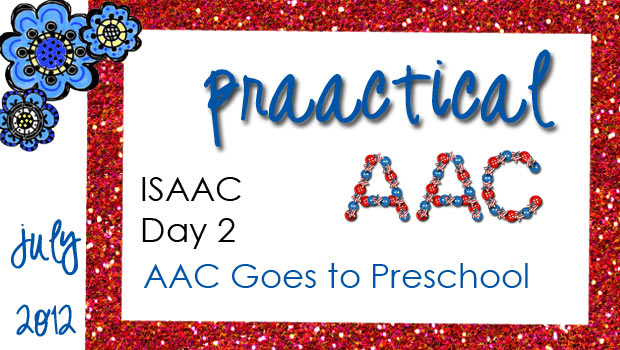
It was another wonderful day here in Pittsburgh at the 15th Biennial ISAAC Conference. It was a special day for me because I had the opportunity to speak about a really fun topic, core vocabulary teaching for young children with AAC needs. It was certainly a group effort! A talented graduate student of ours, Tathiane Paiva, and I shared a framework for developing a curriculum to teach core language in preschool classrooms, and used the curriculum I developed with Lori Wise (special educator and literacy specialist with UM NSU CARD) as an example. The basic principles behind the approach we shared are listed below. – •Language and literacy learning happen all day long. •Children learning AAC need high-quality instruction to learn and use basic vocabulary. •Children learning AAC need frequent opportunities for learning and practice. They need dozens of carefully planned opportunities to use their new words each day. •The focus is on... [Read More...]
July 28, 2012
by Robin Parker -
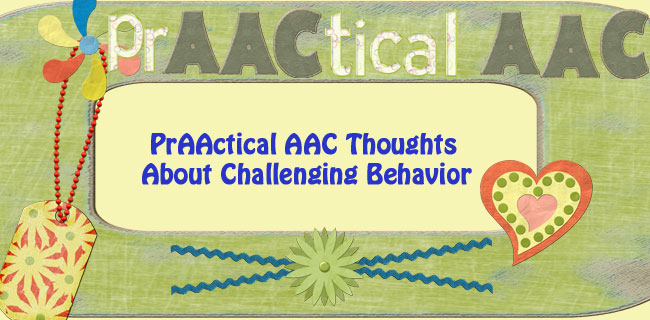
Some PrAACtical AAC thoughts about challenging behavior: I wonder if it is ok to say that we love seeing challenging behavior during speech-language therapy sessions or observations. Well, I said it, both of us do, because if we really ‘listen’ then we can figure out what to teach that will really help our students. We tend to prioritize our goals into High Priority and General Priority. Challenging behavior and the communication message behind it, definitely falls into high priority. This is because challenging behavior in students limits experiences, limits interaction, and overall limits opportunities for people to get to know you. Consider Challenging Behavior through Communication Glasses Is it really Challenging Behavior? behavior that is or can be destructive or hurtful. Examples include but are not limited to: hitting, biting, spitting, throwing, pounding, etc. (Note: we are not talking about poor eye contact or poor attention to task or even laughing... [Read More...]
July 21, 2012
by Robin Parker -
A ‘funny area’ is not a technique or strategy you will see in a behavior or speech-language therapy text-book. But here is how we came to know and love ‘funny time’ & the ‘funny area’ A Little Background Tommy, a 9-year-old boy, seemed to be getting the ‘giggles’ each session. The graduate student clinician was not sure how to ‘control the situation’. Tommy typically worked hard using his Vantage Lite to build long and complex sentences for communication during natural age-appropriate activities (i.e., golf, art, and reading). But then the ‘giggles’ would start… and less and less communication was getting done. Initially, the clinician spent time redirecting Tommy. She would have him sit straight, pay more attention, and re-focus, but in the long run it would be more about what the clinician wanted then about Tommy communicating. We prompted the graduate student to think about how more could be accomplished,... [Read More...]
July 20, 2012
by Robin Parker -
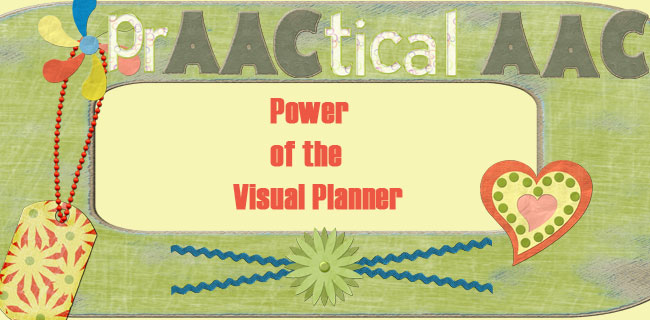
We need to continue to talk about scheduling…..especially as we talk about tools for positive behavioral supports. We know that having monthly, daily, and mini-schedules make us ALL feel more competent and calm. We have written a lot about visual schedules and visual schedule resources because we have seen schedules reduce or eliminate so many behavior challenges. They have helped with transitions, wandering away during activities, activity completion, asking repetitive ‘‘when are we going ________ questions, and with meltdowns during a less preferred activity. We also continue to write about schedules because there are still myths suggesting schedules might hinder independence when exactly the opposite is true. We personally continue to use a combination of no-tech to high-tech visual schedules, but we are loving mobile schedules especially during the summer when we are traveling and moving around from place to place even more frequently than usual. We gathered together... [Read More...]
July 18, 2012
by Carole Zangari -
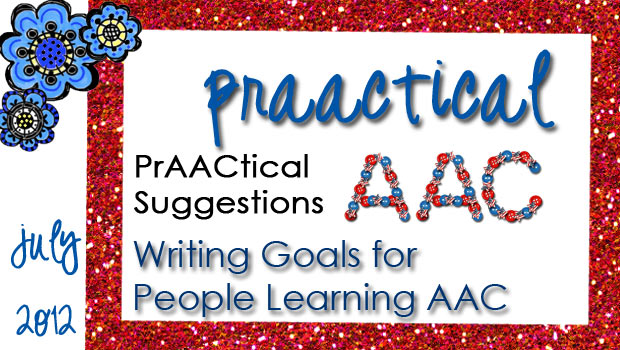
This post was inspired by a budding young professional who loves AAC and is DETERMINED to provide best practice services for the young students she serves. (See?? This is why we love being clinical educators!) We were chatting about a youngster on her caseload who uses an eyegaze SGD and is making some good progress with the technical aspects of it. Our conversation turned to goal setting. – First, a word about how to talk about AAC in the goals and objectives. For people who use SGDs, there are pros and cons to naming the actual device in the goal. Some SLPs favor that, while others prefer a more flexible approach and describe the device features. More about that another time. A more general concern about writing AAC goals is the tendency to focus more on operating equipment than on becoming an effective communicator. Clearly, we advocate the latter: AAC... [Read More...]
July 14, 2012
by Carole Zangari -
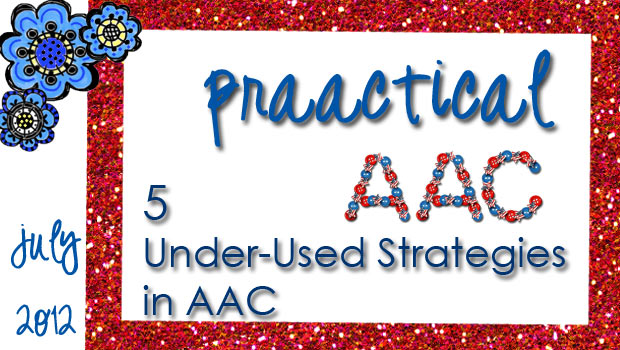
1. Partner-assisted scanning (PAS) offers great flexibility and spontaneity. Don’t want to take your SGD to the beach? A print-out of the screens and PAS is a great option. Missing key messages for the trip to the doctor’s office? A minute of brainstorming and the use of PAS may just save the day. No way for your client to access her device once she’s in bed? A communication board/book and PAS just might do the trick. – 2. Voice banking: For people are likely to lose their speech due to a degenerative disease, like ALS, the option of saving samples of their speech and having it digitized for future use seems to hold great appeal. We’d love to see more SLPs familiarize themselves with this strategy and the tools to implement it, so that this option is more widely used about individuals whose speech is deteriorating. – 3. Qualitative rating... [Read More...]
July 7, 2012
by Carole Zangari -
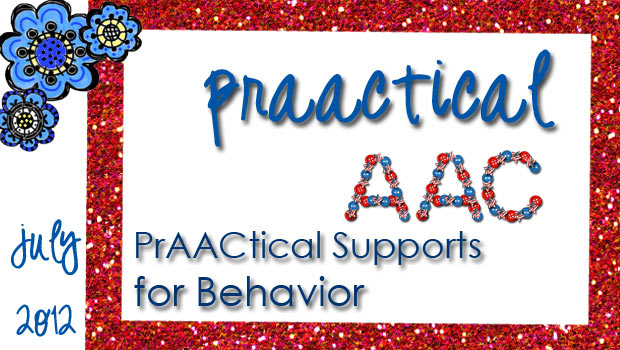
Rachel arrives to therapy tense and upset. Mauro gets frustrated when the clinician presents new activities. Brianna starts to bang the table when demands are placed on her. Zach becomes agitated when he has to wait for something he wants. – Like any set of tools and strategies, AAC works best when the communicator is relaxed, confident, and engaged. Our July Strategy of the Month focuses on PrAACtical Supports for Behavior. We hope to share ideas for planning therapy sessions that help AAC learners stay focused, calm, and engaged. — We’re big believers in the old adage that an ounce of prevention is worth a pound of cure. So, what can we do to prevent or minimize problems like the ones experienced by Rachel, Mauro, Brianna, and Zach? The answers have to do with having clear and appropriate expectations, and using visual and AAC supports effectively. When used consistently, these strategies... [Read More...]
June 27, 2012
by Carole Zangari -
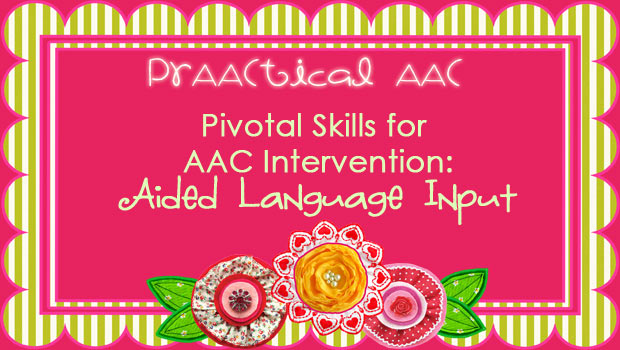
We can’t seem to stop talking about the power of aided language input. It’s one of those strategies that make our sessions more effective and make our clinicians more comfortable with the learner’s AAC system. And when other team members see us using it, they can’t help but pick up on the importance of aided modeling for people who are still learning to use their communication boards, books, SGDs, and mobile devices. – Modeling, AAC Style (clinical rationale, research supports) AACtual Progress: Learning to use Aided Language Input (lessons learned) Strategy of the Month: Aided Language Input (screencast overview) Using the Device/App: Getting the Team on Board (implementation) Teachers in AACtion: Aided Language Input (video) Why We Love Aided Language Input (clinical rationale) Curated Resources for Aided Language Input (miscellaneous info, videos) Video of the Week: Aided Language Input Demo (video) 5 Tools to Make Aided Language Input Easier –








